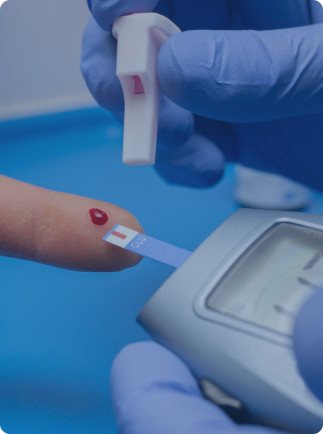Diabetes is a serious health condition that affects millions of people around the world, including more than 2.5 crore individuals in India. It is a chronic disease that impacts how your body controls the level of sugar in your blood. In this blog post, we will break down the various aspects of diabetes in simple and easy-to-understand language for patients and their families.
Types of Diabetes
There are several types of diabetes, but the most common ones are:
1. Type 1 Diabetes: This type occurs when the body doesn't produce insulin, a hormone that regulates blood sugar levels. It often develops in childhood or adolescence.
2. Type 2 Diabetes: Type 2 diabetes is characterized by insulin resistance, where the body's cells do not respond effectively to insulin. It is more common in adults and is often linked to lifestyle factors.
3. Gestational Diabetes: This type occurs during pregnancy when blood sugar levels rise. It usually resolves after childbirth, but it can increase the risk of developing type 2 diabetes later in life.
4. MODY (Maturity Onset Diabetes of the Young): MODY is a rare form of diabetes that typically runs in families and is caused by specific genetic mutations.
Risk Factors for Diabetes
Certain factors increase the risk of developing diabetes. These include:
1. Age above 40
2. Inactive lifestyle
3. High blood pressure
4. High cholesterol
5. Being overweight
6. A family history of diabetes
7. High sugar levels (A1C) or fasting blood sugar levels
Understanding Your Blood Sugar Levels
It's important to know your blood sugar levels, as they play a crucial role in diabetes management.
Here are the key numbers:
Diabetes: A1C level of 6.5% or above, fasting blood sugar level of 126 mg/dl or above, or a glucose tolerance test result of 200 mg/dl or above.
Prediabetes: A1C level between 5.7% and 6.4%, fasting blood sugar level between 100 and 125 mg/dl.
Normal: A1C level below 5.7%, fasting blood sugar level below 99 mg/dl.
Symptoms of Hypoglycemia and Hyperglycemia
Hypoglycemia (low blood sugar) and hyperglycemia (high blood sugar) can both have serious consequences.
Recognizing the symptoms is vital.
Hypoglycemia Symptoms:
Shaking
Sweating
Irritability
Dizziness
Hunger
Confusion
Hyperglycemia Symptoms:
Extreme thirst
Frequent urination
Fatigue
Blurred vision
Slow wound healing
Diabetes Complications
Uncontrolled diabetes can lead to various complications including
Stroke
Heart disease
Retinopathy (eye damage)
Peripheral neuropathy
Nephropathy (kidney damage)
Diabetic foot problems
Diabetes Treatment and Prevention
Managing diabetes involves the following steps:
1. Visit a doctor for diagnosis and regular check-ups.
2. Maintain a healthy diet, controlling portions and avoiding excessive sugar and fat.
3. Stay physically active.
4. Avoid smoking and limit alcohol consumption.
Myths and Facts about Diabetes
Let's dispel some common myths about diabetes:
1. Myth: Diabetes isn't serious.
Fact: It can be life-threatening and is a leading cause of death worldwide.
2. Myth: Diabetes only runs in families.
Fact: Other factors like an unhealthy diet and physical inactivity can also increase the risk.
3. Myth: Eating sugar causes diabetes.
Fact: Excess calorie consumption, not just sugar, can lead to diabetes.
4. Myth: People with diabetes can't exercise.
Fact: Exercise is beneficial for people with diabetes.
5. Myth: Diabetes always shows symptoms.
Fact: Type 2 diabetes can develop with few or no symptoms initially.
6. Myth: Weight loss for diabetes management is extreme.
Fact: Even a modest weight loss can offer significant health benefits.
Steps for Better Living with Diabetes
To lead a healthy life with diabetes, follow these steps:
Eat healthy
Be active
Monitor blood sugar levels
Take medications as prescribed
Problem solve
Reduce risk
Cope well
Conclusion
Diabetes is a manageable condition with proper care and lifestyle changes. By understanding its types, symptoms, risk factors, and treatment options, you can take control of your health and lead a fulfilling life despite diabetes. Remember, you're not alone, and support from healthcare professionals, family, and friends is essential on your journey to managing diabetes.





